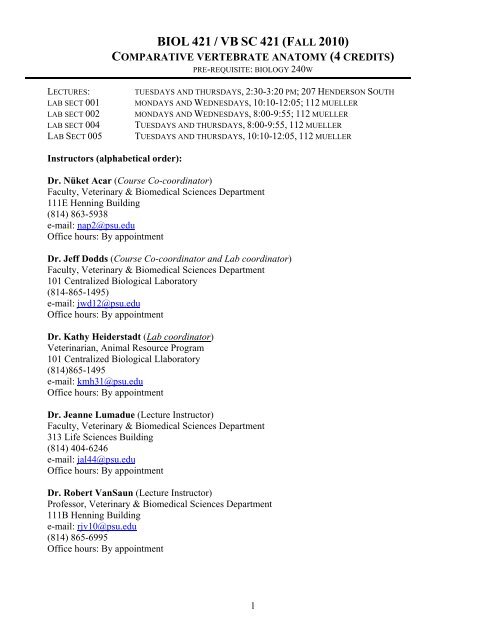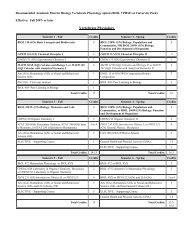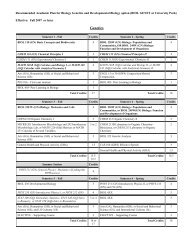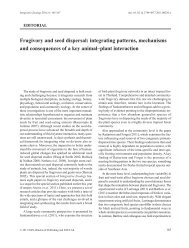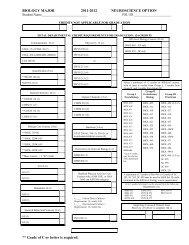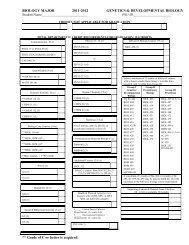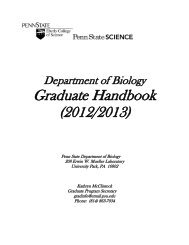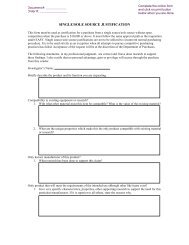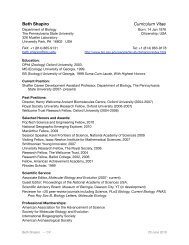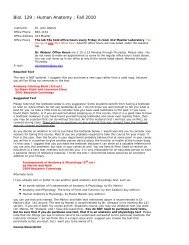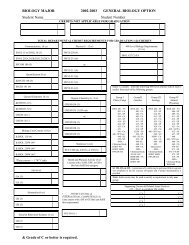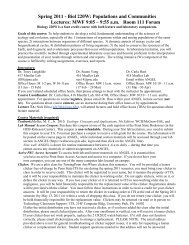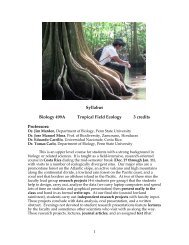BIOL 421 / VB SC 421 (F ALL 2010) - Department of Biology
BIOL 421 / VB SC 421 (F ALL 2010) - Department of Biology
BIOL 421 / VB SC 421 (F ALL 2010) - Department of Biology
You also want an ePaper? Increase the reach of your titles
YUMPU automatically turns print PDFs into web optimized ePapers that Google loves.
<strong>BIOL</strong> <strong>421</strong> / <strong>VB</strong> <strong>SC</strong> <strong>421</strong> (F<strong>ALL</strong> <strong>2010</strong>)<br />
COMPARATIVE VERTEBRATE ANATOMY (4 CREDITS)<br />
PRE-REQUISITE: <strong>BIOL</strong>OGY 240W<br />
LECTURES: TUESDAYS AND THURSDAYS, 2:30-3:20 PM; 207 HENDERSON SOUTH<br />
LAB SECT 001 MONDAYS AND WEDNESDAYS, 10:10-12:05; 112 MUELLER<br />
LAB SECT 002 MONDAYS AND WEDNESDAYS, 8:00-9:55; 112 MUELLER<br />
LAB SECT 004 TUESDAYS AND THURSDAYS, 8:00-9:55, 112 MUELLER<br />
LAB SECT 005 TUESDAYS AND THURSDAYS, 10:10-12:05, 112 MUELLER<br />
Instructors (alphabetical order):<br />
Dr. Nüket Acar (Course Co-coordinator)<br />
Faculty, Veterinary & Biomedical Sciences <strong>Department</strong><br />
111E Henning Building<br />
(814) 863-5938<br />
e-mail: nap2@psu.edu<br />
Office hours: By appointment<br />
Dr. Jeff Dodds (Course Co-coordinator and Lab coordinator)<br />
Faculty, Veterinary & Biomedical Sciences <strong>Department</strong><br />
101 Centralized Biological Laboratory<br />
(814-865-1495)<br />
e-mail: jwd12@psu.edu<br />
Office hours: By appointment<br />
Dr. Kathy Heiderstadt (Lab coordinator)<br />
Veterinarian, Animal Resource Program<br />
101 Centralized Biological Llaboratory<br />
(814)865-1495<br />
e-mail: kmh31@psu.edu<br />
Office hours: By appointment<br />
Dr. Jeanne Lumadue (Lecture Instructor)<br />
Faculty, Veterinary & Biomedical Sciences <strong>Department</strong><br />
313 Life Sciences Building<br />
(814) 404-6246<br />
e-mail: jal44@psu.edu<br />
Office hours: By appointment<br />
Dr. Robert VanSaun (Lecture Instructor)<br />
Pr<strong>of</strong>essor, Veterinary & Biomedical Sciences <strong>Department</strong><br />
111B Henning Building<br />
e-mail: rjv10@psu.edu<br />
(814) 865-6995<br />
Office hours: By appointment<br />
1
Laboratory Teaching Assistants<br />
Section 001 (Monday and Wednesday 10:10 – 12:05)<br />
Section 002 (Monday and Wednesday 8:00 – 9:55)<br />
Teaching Assistant: Anna Stanhewicz<br />
e-mail: axs1056@psu.edu<br />
Office: Noll, room 129<br />
Office Phone: 863-2948<br />
Office Hours: Fridays from 9:00-10:30<br />
Section 004 (Tuesday and Thursday 8:00 – 9:55)<br />
Teaching Assistant: Kelsey Krebs<br />
e-mail: kjk5103@psu.edu<br />
Office Hours: Fridays from 10:30-11:30<br />
Section 005 (Tuesday and Thursday 10:10-12:05)<br />
Teaching Assistant: Natalie Herron<br />
e-mail: nvh5012@psu.edu<br />
Office Hours: Fridays from 2:30-3:30<br />
Text:<br />
Vertebrates, Comparative Anatomy, Function, Evolution by Kenneth Kardong, McGraw-Hill, 2009<br />
(5 th Edition). Note: Older editions <strong>of</strong> this text may be used. However, students should be aware that<br />
reading assignments are based on the most recent edition. Page and illustration numbers may not exactly<br />
match when older editions are used.<br />
Laboratory Manual (Required)<br />
Comparative Anatomy: Manual <strong>of</strong> Vertebrate Dissection Second Edition by Fishbeck and<br />
Sebastiani, Morton Publishing Company, 2008. The laboratory manual (second edition) is required.<br />
Students should not attempt to use older versions <strong>of</strong> this manual.<br />
COURSE DE<strong>SC</strong>RIPTION<br />
Course Objectives:<br />
This course is designed to provide students with a broadly applicable understanding <strong>of</strong> anatomy.<br />
• Knowledge and understanding <strong>of</strong> anatomic structure and terminology is a basic requirement<br />
<strong>of</strong> the biological sciences and forms the foundation for many related disciplines.<br />
• Those students who pursue higher degrees in such areas as human or veterinary medicine will<br />
find that there are many similarities between the examples provided in this course and the<br />
species in which they specialize.<br />
• However, pre-pr<strong>of</strong>essional students should understand that the focus <strong>of</strong> this course is neither<br />
human nor veterinary anatomy.<br />
2
By the end <strong>of</strong> the semester students will have accomplished the following:<br />
1. Students will be able to identify anatomic structures and understand their function.<br />
2. Students will have become familiar with the evolutionary history <strong>of</strong> vertebrates as well as with<br />
vertebrate taxonomy and basic concepts <strong>of</strong> embryonic development.<br />
3. Students will understand the relationship between anatomic structure and function and be able to<br />
use comparisons between ancestral and descendant vertebrate species to illustrate evolutionary<br />
adaptations.<br />
4. Students will have become familiar with basic concepts <strong>of</strong> embryology including differentiation<br />
<strong>of</strong> tissues and organ formation which provides a basis for understanding organ structure as well as<br />
the relationship <strong>of</strong> an organ to other structures in the body.<br />
5. Students will have examined the development <strong>of</strong> structures that have homologues in ancestral<br />
and/or descendant species and illustrate parallels between evolutionary and developmental<br />
biology.<br />
Comparisons <strong>of</strong> structure, function, and embryonic development between representatives <strong>of</strong> various<br />
vertebrate taxa will be used throughout the semester necessitating thorough understanding and retention<br />
<strong>of</strong> this material.<br />
Laboratory objectives:<br />
Laboratory exercises will involve work with preserved laboratory specimens and will focus heavily on<br />
anatomic structure identification. Areas <strong>of</strong> study include anatomic directional terminology, vertebrate<br />
classification systems, early embryonic development, a detailed examination <strong>of</strong> the skeletal system and a<br />
series <strong>of</strong> dissections <strong>of</strong> the various organ systems.<br />
� Specimens are selected to illustrate the anatomy <strong>of</strong> early vertebrate species, the evolutionary<br />
changes observed in descendant species and the association <strong>of</strong> morphology with lifestyle.<br />
� Although multiple species will be examined, students will invest the majority <strong>of</strong> their time<br />
becoming familiar with the anatomy <strong>of</strong> a representative mammal (the cat).<br />
� However, students will be expected to recognize selected anatomic structures in each species<br />
studied.<br />
COURSE POLICIES<br />
Lecture Exams<br />
Tests will focus on material presented during lectures as well as material covered in assigned reading.<br />
Each exam will focus on material covered since the previous test. However, some test questions may<br />
require knowledge <strong>of</strong> material presented earlier in the course.<br />
There will be two midterm exams and a non-comprehensive final exam worth a total <strong>of</strong> 400 points.<br />
Exams will be weighted based on the number <strong>of</strong> lectures covered on each exam.<br />
Midterm Exam #1 – Thursday, September 30 th , will count for approximately 33% <strong>of</strong> the lecture grade<br />
Midterm Exam #2 – Tuesday, November 2 nd , will count for approximately 33% <strong>of</strong> the lecture grade<br />
Final Exam (non-comprehensive) will count for approximately 33% <strong>of</strong> the lecture grade.<br />
Laboratory Exams<br />
Laboratory exams will focus on structure identification and function. Any information covered in<br />
assigned reading and in lab exercises may be included in the lab exams. Emphasis will be placed on<br />
material presented since the last prior exam. However, some exam questions may require knowledge <strong>of</strong><br />
material presented earlier in the course.<br />
3
Lab Exam Schedule:<br />
Laboratory Exams are administered on Fridays (Times to be scheduled).<br />
Lab Exam #1 – Friday, September 24 th , Mueller Room 112<br />
Lab Exam #2 – Friday, October 29 th , Mueller Room 112<br />
Lab Exam #3 – Friday, December 10 th , Mueller Room 112<br />
Laboratory Quizzes<br />
Quizzes will cover material presented in the laboratory and assigned reading. Emphasis will be placed on<br />
material presented since the last prior quiz. However, some quiz questions may require knowledge <strong>of</strong><br />
material presented earlier in the course. Quiz scores will be combined with the scores from lab exercises<br />
for a combined total <strong>of</strong> 160 points. The lowest quiz score will be dropped.<br />
Laboratory Exercises<br />
Laboratory exercises are to be completed and turned in at the end <strong>of</strong> the laboratory period. The laboratory<br />
exercises will contribute to the final grade as described below. Attendance at the laboratory session is<br />
required in order to receive credit for the exercise. Students who miss a laboratory session due to an<br />
excused absence should arrange a make up assignment with the instructor.<br />
Grading<br />
Laboratory exams = 240 points<br />
Lab exercises and Quizzes = 160 points<br />
Lecture & Final exams = 400 points<br />
Total = 800 points<br />
4<br />
95-100% = A<br />
90-94% = A-<br />
87-89% = B+<br />
83-86% = B<br />
80-82% = B-<br />
77-79% = C+<br />
70-76% = C<br />
60-69%= D<br />
Below 60% = F<br />
Illness and Excused Absence<br />
Notify a Course Coordinator (Dr. Acar or Dr. Dodds) in advance if you will not be able to attend an<br />
exam or laboratory session. Let us know as soon as possible; don’t wait to the last minute. If an<br />
examination is missed as arranged with a course coordinator or due to illness, a make-up examination<br />
will be arranged promptly at a mutually convenient time for the instructor and the involved student.<br />
Missed laboratory sessions and quizzes must be made up during scheduled <strong>of</strong>fice hours.<br />
Unexcused Absence:<br />
Lab exercises turned in late due to an unexcused absence may (at the discretion <strong>of</strong> the instructor) be<br />
subject to a grade reduction <strong>of</strong> up to 50%.<br />
Laboratory Safety<br />
Eye protection is not required, but students who wear contact lenses should know that the embalming<br />
fluids that preserve the specimens can cause eye irritation. Inform your TA if you feel faint or nauseous<br />
during the laboratory period. Use <strong>of</strong> scalpels should be limited to dissections which cannot be completed<br />
with scissors or by blunt dissection. If you hurt yourself during a lab session please see your lab<br />
instructor immediately so that they can administer first aid and report your injury.<br />
Laboratory Specimens<br />
This lab will involve examination and dissection <strong>of</strong> preserved animals. Students are expected to treat all<br />
lab specimens with respect. Photography <strong>of</strong> lab specimens by students will not be allowed and may<br />
result in removal <strong>of</strong> students from the lab. All dissection specimens, bones, models, charts, and etc.,
are to remain in the lab. Anyone caught removing lab material will fail the course. Separate waste<br />
disposal bins will be provided for animal tissue and for regular lab trash, which must be kept separate.<br />
Students caught improperly disposing <strong>of</strong> trash will be expected to fix the problem. The laboratory TA<br />
may assign any student from his/her lab section to remove biological waste from the regular trash.<br />
Classroom Courtesy<br />
1. Turn your cell phone <strong>of</strong>f or set it to vibrate before class. Leave the room if you need to speak on<br />
the phone.<br />
2. Food and beverage consumption is not permitted in the classroom.<br />
3. Leave the classroom in good condition for the next class (i.e., rearrange moved chairs, etc.; Throw<br />
away your trash).<br />
4. Treat everyone in the class with respect. Derogatory or demeaning comments towards any group<br />
or person will not be tolerated.<br />
Suggestions<br />
1. Complete the laboratory reading assignment prior to lab. You are likely to learn more during lab<br />
if you have prepared in advance.<br />
2. Turn laboratory assignments in at the completion <strong>of</strong> the lab session. Assignments that are turned<br />
in late will not be graded unless arranged for in advance.<br />
3. Attend every class. In general, those who attend class achieve higher grades.<br />
Academic Integrity<br />
Cheating is turning in someone else’s work as your own.<br />
Cheating is “getting advice” from another student, or source, during an exam.<br />
Cheating is cutting and pasting someone else’s words into your project without giving credit.<br />
Cheating is NOT using a correctly cited quote from someone else’s work to make your point.<br />
Cheating is NOT working with another student inside or outside <strong>of</strong> class.<br />
Cheating is NOT making mistakes, asking questions and fixing errors – that’s learning!<br />
Academic integrity, as defined by University Faculty Senate Policy 49-20, is the pursuit <strong>of</strong><br />
scholarly activity free from fraud and deception and is an educational objective <strong>of</strong> this institution.<br />
Academic dishonesty includes, but is not limited to, cheating, plagiarizing, fabricating <strong>of</strong><br />
information or citations, facilitating acts <strong>of</strong> academic dishonesty by others, having unauthorized<br />
possession <strong>of</strong> examinations, submitting work <strong>of</strong> another person or work previously used without<br />
informing the instructor, or tampering with the academic work <strong>of</strong> other students. Violations <strong>of</strong><br />
academic integrity will result in sanction including, but not limited to, a zero grade on the<br />
assignment in question and documentation <strong>of</strong> the incident with Judicial Affairs.<br />
If you are so overwhelmed that you have considered cheating, please see me. I will be happy to<br />
help. The goal is to learn, not just to get a grade.<br />
Note to Students with Disabilities<br />
Penn State welcomes students with disabilities into the University's educational programs. If you<br />
have a disability-related need for modifications or reasonable accommodations in this course,<br />
contact the Office for Disability Services, ODS, located at 116 Boucke Building at 1-814-863-<br />
1807(V/TTY). For further information regarding ODS please visit their web site at<br />
http://www.lions.psu.edu/ods/. Instructors should be notified as early in the semester as possible<br />
regarding the need for modification or reasonable accommodations. If you have a disability please<br />
let us know. We have always been able to find ways to accommodate students' special needs for<br />
this course.<br />
5
LECTURE <strong>SC</strong>HEDULE<br />
Lec. Date Subjects Reading Instructor<br />
1 Aug 24 Introduction All<br />
2 Aug 26 Terminology/Basic concepts Chapter 1 Dr. Lumadue<br />
3 Aug 31 Origin <strong>of</strong> Chordates Chapter 2 Dr. Van Saun<br />
4 Sept 2 The Vertebrate Story Chapter 3 Dr. Van Saun<br />
5 Sept 7 Biological design Chapter 4 Dr. Lumadue<br />
6 Sept 9 Skeletal system: The skull Chapter 7 Dr. Van Saun<br />
7 Sept. 14 Skeletal system: The skull Chapter 7 Dr. Van Saun<br />
8 Sept. 16 Life history Chapter 5 Dr. Lumadue<br />
9 Sept. 21 Life history Chapter 5 Dr. Lumadue<br />
10 Sept. 23 The Integument Chapter 6 Dr. Lumadue<br />
11 Sept. 28 Skeletal system: The axial skeleton Chapter 8 Dr. Van Saun<br />
Sept. 30 Midterm I (covers lectures 1-10)<br />
12 Oct. 5 Skeletal system: appendicular skeleton Chapter 9 Dr. Van Saun<br />
13 Oct. 7 The muscular system Chapter 10 Dr. Van Saun<br />
14 Oct. 12 The digestive system Chapter 13 Dr. Van Saun<br />
15 Oct. 14 The digestive system Dr. Van Saun<br />
16 Oct. 19 The respiratory system Chapter 11 Dr. Lumadue<br />
17 Oct. 21 The respiratory system Dr. Lumadue<br />
18 Oct. 26 The circulatory system Chapter 12 Dr. Lumadue<br />
19 Oct. 28 The circulatory system Dr. Lumadue<br />
Nov. 2 Midterm II (covers lectures 11-19)<br />
20 Nov. 4 The urogenital system Chapter 14 Dr. Van Saun<br />
21 Nov. 9 The urogenital system Dr. Van Saun<br />
22 Nov. 11 The nervous system Chapter 16 Dr. Van Saun<br />
23 Nov. 16 The nervous system Dr. Lumadue<br />
24 Nov. 18 The endocrine system Chapter 15 Dr. Lumadue<br />
Nov 22-26 Thanksgiving Holiday – No class<br />
25 Nov. 30 Sensory organs Chapter 17 Dr. Van Saun<br />
26 Dec. 2 Sensory organs Dr. Lumadue<br />
27 Dec. 7 Avian anatomy Dr Acar<br />
28 Dec. 9 Material Review – SRTE Drs. Lumadue/Van Saun<br />
Finals<br />
Week<br />
Exam III (covers lectures 20-28)<br />
6
<strong>2010</strong> Laboratory Schedule<br />
This schedule is subject to change at the instructor’s discretion. The lab manual* and the Kardong<br />
textbook will be used as references during the labs. Reading assignments will be posted on the Angel<br />
web page before each lab. Please review the readings each week before lab and bring the lab manual to<br />
the lab session. Additional handouts will be used in some labs and will be posted on the Angel web page<br />
before each lab. These will be necessary to complete the labs and should be printed out by students<br />
before coming to lab.<br />
* Comparative Anatomy: Manual <strong>of</strong> Vertebrate Dissection, Second Edition. Fishbeck DW and<br />
Sebastiani A, 2008. Morton Publishing Company.<br />
Date Topic Lab<br />
Aug. 23/24 No labs<br />
Aug. 25/26 Anatomic - Directional Terminology & Cladistics 1<br />
Aug. 30/31 Chordate/General vertebrate features 2<br />
Sept. 1/2 Embryology/development, 3<br />
Sept. 6/7 No labs<br />
Sept. 8/9 Skeletal system-skull QUIZ 1 4<br />
Sept. 13/14 Skeletal system-skull 5<br />
Sept. 15/16 Skeletal system-axial, 6<br />
Sept. 20/21 Skeletal system-appendicular QUIZ 2 7<br />
Sept. 22/23 Review Day<br />
Sept. 24 Lab Exam 1 covering labs 1-7<br />
Sept. 27/28 Locomotion 8<br />
Sept. 29/30 External Anatomy/Integument 9<br />
Lecture Exam September 30 th<br />
Oct. 4/5 Skinning the cat, muscular system, 10<br />
Oct. 6/7 Muscular system Quiz 3 11<br />
Oct. 11/12 Muscular system 12<br />
Oct. 13/14 Muscular system, 13<br />
Oct. 18/19 Digestive system & Body Cavities Quiz 4 14<br />
Oct. 20/21 Digestive System comparisons 15<br />
Oct. 25/26 Respiratory system, 16<br />
Oct. 27/28 Review Day<br />
Oct 29 Lab Exam 2 covering labs 8-16<br />
Nov. 1/2 Urogenital & Endocrine Systems 17<br />
Lecture Exam – Nov 2 nd<br />
Nov. 3/4 Circulatory system 18<br />
Nov. 8/9 Circulatory system, QUIZ 5 19<br />
Nov. 10/11 Circulatory system 20<br />
Nov. 15/16 Circulatory system comparisons 21<br />
Nov. 17/18 Nervous System, Quiz 6 22<br />
Nov. 22-26 Thanksgiving holiday – NO LABS<br />
Nov. 29/30 Nervous System 23<br />
Dec. 1/2 Nervous system, 24<br />
Dec. 6/7 Avian anatomy 25<br />
Dec. 8/9 Review Day<br />
Dec. 10 Lab Exam 3 covering labs 17-25<br />
7


